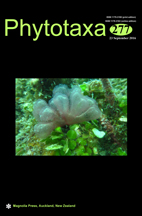Abstract
Philonotis polymorpha (Müller 1883: 79) Kindberg (1889: 79) is a circumsubantarctic species recorded for almost all subantarctic islands, central and southern Chile and Argentina (Ochyra et al., 2008; Müller, 2009; Bednarek-Ochyra, 2014). It was first described as Bartramia polymorpha Müll. Hal. based on specimens collected on Îles Kerguelen by Naumann in 1874, and subsequently transferred to Philonotis (Bridel 1827: 15) by Kindberg (1889). It is a medium sized plant, yellowish-green to reddish-brown below, commonly found growing sterile on wet rocks or soil in forests, near rivers and waterfalls. Diagnostic characters of this species are the dimorphic leaves, ovate to oblong-lanceolate, the abruptly short-acuminate apex, margins plane, serrate at the apex, entire at the base, the excurrent, robust and well defined costae, ending in a mucro, and the papillae projecting at proximal angles of laminal cells. The variability in the leaf morphology led to the description for many taxa along the history (Ochyra et al., 2008). Recently, Bednarek-Ochyra (2014) proposed Philonotis tenella Kaalaas (1912: 109) from Îles Crozet, as a new synonym of P. polymorpha, completing with these results the range of this species in the subantarctic islands.

